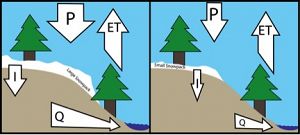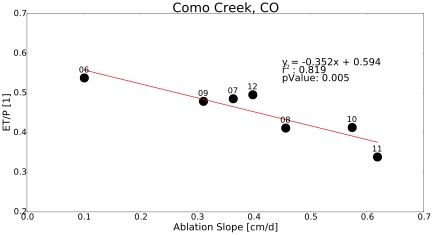Snow Hydrology Group. Theo Barnhart Research Group
The mountain snowpack across the western US is declining in response to anthropogenic climate warming. I seek to understand how changes in snowpack amount, snowmelt rate, and snowmelt timing translate into changes in streamflow production. I also seek the physical mechanism responsible for controlling the snowmelt-streamflow production relationship, using both hydrologic models and collocated measurements of streamflow, snow water equivalent, evapotranspiration, and soil moisture. I employ models at the watershed, point scale and continental scale to test whether the mechanisms we observe in the field apply at larger scales.
Image: Understanding snowmelt and streamflow production. Conceptual model of how the snowpack size relates to the relative magnitude of the hydrologic fluxes in a subalpine forest. Evapotranspiration (ET) does not vary greatly from year to year, but changes in snowpack size control infiltration to the soil column and the flux of water to the stream.
This group is tagged with:
-
To understand at a process level how changes in snowmelt rate will alter hydrologic partitioning of snowmelt between evaporative processes and streamflow, I use observations of evapotranspiration and snowmelt rate (ablation slope). We hypothesize that years with larger snowpacks that melt more rapidly are more efficient at driving infiltration below the root zone and contributing to later subsurface flow, which then becomes streamflow (Figure 1). There is a clear relationship between evaporative efficiency (ET/P) and snowmelt rate suggesting that years with more rapid snowmelt partition proportionally less water to evaporative processes than slow years (Figure 2). To explore the direct effects of snowmelt rate and the timing of snowmelt independently I use the Regional Hydo-Ecology Simulation System (RHESSys) in conjunction with a set of snowmelt scenarios that alter the timing and rate of snowmelt to examine the affect these two parameters have on hydrologic partitioning. It is clear that more water is partitioned to streamflow during the ablation season as snowmelt rate increases (Figure 3). The secondary pattern in the data cloud is that slow snowmelt can also generate proportionally high streamflow if it occurs early in the year when vegetation is unable to use the water (Figure 3). These relationships suggest that snowmelt rate exercises an important control on how water is portioned between hydrologic partitioning during the snowmelt season.
Understanding Snowmelt Rate, Timing, and Hydrologic Partitioning. Data cloud representing the relationship between snowmelt rate and snowmelt season hydrologic partitioning colored by snowmelt timing. Streamflow efficiency generally increases with snowmelt rate; however, high streamflow efficiency is possible with early snowmelt (magenta points).
Snowmelt Rate and Hydrologic Partitioning. Years with rapid snowmelt rate (ablation slope) partition proportionally less water to evaporative processes than years with slow snowmelt.
Understanding Snowmelt Rate, Timing, and Hydrologic Partitioning. Data cloud representing the relationship between snowmelt rate and snowmelt season hydrologic partitioning colored by snowmelt timing. Streamflow efficiency generally increases with snowmelt rate; however, high streamflow efficiency is possible with early snowmelt (magenta points).
-
Contacts
-
Boulder, Sierra, INVESTIGATOR
Alumni-Former
GRAD STUDENT
.(JavaScript must be enabled to view this email address)
Snow Hydrology
-
-
Featured Publications
2016 (In Review)
Snowmelt Rate Dictates Streamflow . Barnhart, T.B., Molotch, N.P., Harpold, A., Knowles, J., Livneh, B., and Schneider, D., (2016): Geophysical Research Letters.
2015
Sensitivity of Hydrologic Partitioning to Snowpack Dynamics . Barnhart, T.B., Molotch, N.P., Livneh, B., Harpold, A.A., Knowles, J.F., Anderson, S.P., Bales, R.C., and Hunsaker, C.T. (2015): Poster, presented at the Western Snow Conference, Grass Valley, CA, April 20-23.
2015
Sensitivity of hydrologic partitioning to snowpack dynamics. Barnhart, T.B., Molotch, N.P., Harpold, A., Livneh, B., Knowles, J., and Anderson, S. (2015): Water Sustainability and Climate Principal Investigator Meeting at the National Science Foundation, Arlington, VA, February 9-11.
2014
Sensitivity of hydrologic partitioning to snowpack dynamics, Como Creek, CO, . Barnhart, T.B., Molotch N.P., Harpold A.A., Knowles J.F., and Anderson S.P. (2014): Abstract H51D-0643, poster, AGU Fall Meeting, San Francisco, Calif., 15-19 Dec.
Explore Further




